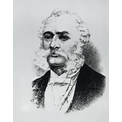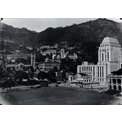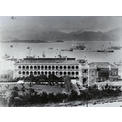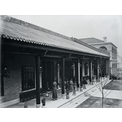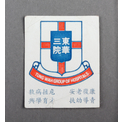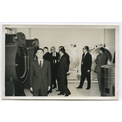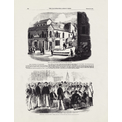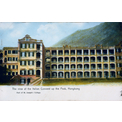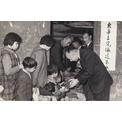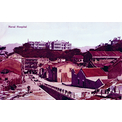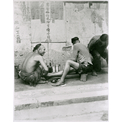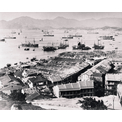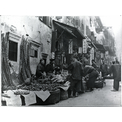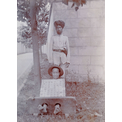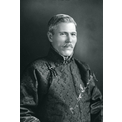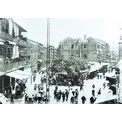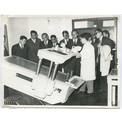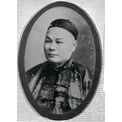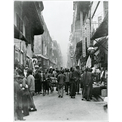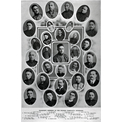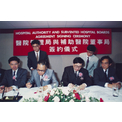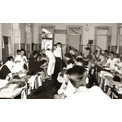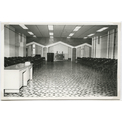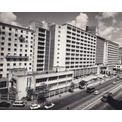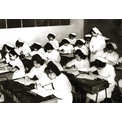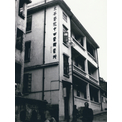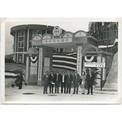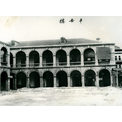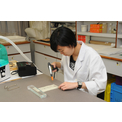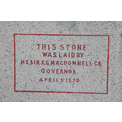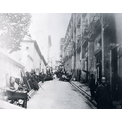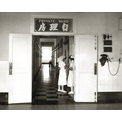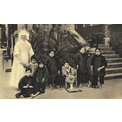 Collections
Collections Hong Kong, Benevolent City: Tung Wah and the Growth of Chinese Communities
Hong Kong, Benevolent City: Tung Wah and the Growth of Chinese Communities All Items
All Items Images
Images
Medicine seller
An apothecary. These medicine sellers were charlatans and were common in China. The advertising sign behind the apothecary claims that he offers cures for such diverse ailments as dysentery, leprosy and tuberculosis, and also that he can reset broken bones. Also captured in this photograph is his stall of remedies.
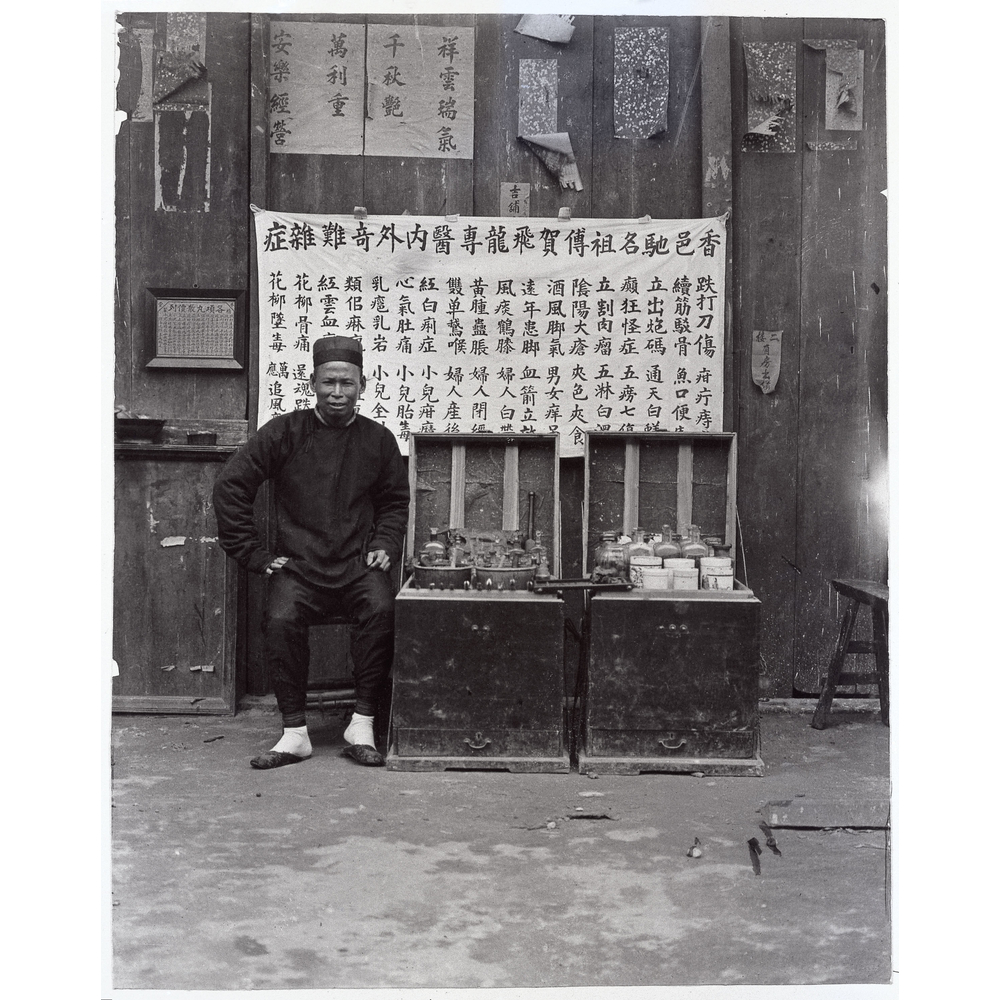
| Date | Late 19th century |
| people | Hawker |
| object | Stall | Advertisement |
| Material Type | Image |
| Collection | Hong Kong, Benevolent City: Tung Wah and the Growth of Chinese Communities |
| Source | Hong Kong Museum of History. Image Reference No.: P1964.402 |
| Repository | Hong Kong Museum of History |
| Note to Copyright | Permission for use in Hong Kong Memory is given by Hong Kong Museum of History |
| Accession No. | lcs-twgh-0027 |
Medicine seller
An apothecary. These medicine sellers were charlatans and were common in China. The advertising sign behind the apothecary claims that he offers cures for such diverse ailments as dysentery, leprosy and tuberculosis, and also that he can reset broken bones. Also captured in this photograph is his stall of remedies.
| Date | Late 19th century |
| People | Hawker |
| Object | Stall | Advertisement |
| Material Type | Image |
| Collection | Hong Kong, Benevolent City: Tung Wah and the Growth of Chinese Communities |
| Source | Hong Kong Museum of History. Image Reference No.: P1964.402 |
| Repository | Hong Kong Museum of History |
| Note to Copyright | Permission for use in Hong Kong Memory is given by Hong Kong Museum of History |
| Accession No. | lcs-twgh-0027 |
Medicine seller
An apothecary. These medicine sellers were charlatans and were common in China. The advertising sign behind the apothecary claims that he offers cures for such diverse ailments as dysentery, leprosy and tuberculosis, and also that he can reset broken bones. Also captured in this photograph is his stall of remedies.
| Date | Late 19th century |
| People | Hawker |
| Object | Stall | Advertisement |
| Material Type | Image |
| Collection | Hong Kong, Benevolent City: Tung Wah and the Growth of Chinese Communities |
| Source | Hong Kong Museum of History. Image Reference No.: P1964.402 |
| Repository | Hong Kong Museum of History |
| Note to Copyright | Permission for use in Hong Kong Memory is given by Hong Kong Museum of History |
| Accession No. | lcs-twgh-0027 |
Medicine seller
An apothecary. These medicine sellers were charlatans and were common in China. The advertising sign behind the apothecary claims that he offers cures for such diverse ailments as dysentery, leprosy and tuberculosis, and also that he can reset broken bones. Also captured in this photograph is his stall of remedies.
| Date | Late 19th century |
| People | Hawker |
| Object | Stall | Advertisement |
| Material Type | Image |
| Collection | Hong Kong, Benevolent City: Tung Wah and the Growth of Chinese Communities |
| Source | Hong Kong Museum of History. Image Reference No.: P1964.402 |
| Repository | Hong Kong Museum of History |
| Note to Copyright | Permission for use in Hong Kong Memory is given by Hong Kong Museum of History |
| Accession No. | lcs-twgh-0027 |
Medicine seller
An apothecary. These medicine sellers were charlatans and were common in China. The advertising sign behind the apothecary claims that he offers cures for such diverse ailments as dysentery, leprosy and tuberculosis, and also that he can reset broken bones. Also captured in this photograph is his stall of remedies.
| Date | Late 19th century |
| People | Hawker |
| Object | Stall | Advertisement |
| Material Type | Image |
| Collection | Hong Kong, Benevolent City: Tung Wah and the Growth of Chinese Communities |
| Source | Hong Kong Museum of History. Image Reference No.: P1964.402 |
| Repository | Hong Kong Museum of History |
| Note to Copyright | Permission for use in Hong Kong Memory is given by Hong Kong Museum of History |
| Accession No. | lcs-twgh-0027 |
Medicine seller
An apothecary. These medicine sellers were charlatans and were common in China. The advertising sign behind the apothecary claims that he offers cures for such diverse ailments as dysentery, leprosy and tuberculosis, and also that he can reset broken bones. Also captured in this photograph is his stall of remedies.
| Date | Late 19th century |
| People | Hawker |
| Object | Stall | Advertisement |
| Material Type | Image |
| Collection | Hong Kong, Benevolent City: Tung Wah and the Growth of Chinese Communities |
| Source | Hong Kong Museum of History. Image Reference No.: P1964.402 |
| Repository | Hong Kong Museum of History |
| Note to Copyright | Permission for use in Hong Kong Memory is given by Hong Kong Museum of History |
| Accession No. | lcs-twgh-0027 |
Medicine seller
An apothecary. These medicine sellers were charlatans and were common in China. The advertising sign behind the apothecary claims that he offers cures for such diverse ailments as dysentery, leprosy and tuberculosis, and also that he can reset broken bones. Also captured in this photograph is his stall of remedies.
| Date | Late 19th century |
| People | Hawker |
| Object | Stall | Advertisement |
| Material Type | Image |
| Collection | Hong Kong, Benevolent City: Tung Wah and the Growth of Chinese Communities |
| Source | Hong Kong Museum of History. Image Reference No.: P1964.402 |
| Repository | Hong Kong Museum of History |
| Note to Copyright | Permission for use in Hong Kong Memory is given by Hong Kong Museum of History |
| Accession No. | lcs-twgh-0027 |
Medicine seller
An apothecary. These medicine sellers were charlatans and were common in China. The advertising sign behind the apothecary claims that he offers cures for such diverse ailments as dysentery, leprosy and tuberculosis, and also that he can reset broken bones. Also captured in this photograph is his stall of remedies.
| Date of Death | Late 19th century |
| People | Hawker |
| Object | Stall | Advertisement |
| Material Type | Image |
| Collection | Hong Kong, Benevolent City: Tung Wah and the Growth of Chinese Communities |
| Source | Hong Kong Museum of History. Image Reference No.: P1964.402 |
| Repository | Hong Kong Museum of History |
| Note to Copyright | Permission for use in Hong Kong Memory is given by Hong Kong Museum of History |
| Accession No. | lcs-twgh-0027 |
Medicine seller
An apothecary. These medicine sellers were charlatans and were common in China. The advertising sign behind the apothecary claims that he offers cures for such diverse ailments as dysentery, leprosy and tuberculosis, and also that he can reset broken bones. Also captured in this photograph is his stall of remedies.
| Date | Late 19th century |
| Material Type | Image |
| Collection | Hong Kong, Benevolent City: Tung Wah and the Growth of Chinese Communities |
| Source | Hong Kong Museum of History. Image Reference No.: P1964.402 |
| Note to Copyright | Permission for use in Hong Kong Memory is given by Hong Kong Museum of History |
| Accession No. | lcs-twgh-0027 |
Medicine seller
An apothecary. These medicine sellers were charlatans and were common in China. The advertising sign behind the apothecary claims that he offers cures for such diverse ailments as dysentery, leprosy and tuberculosis, and also that he can reset broken bones. Also captured in this photograph is his stall of remedies.
| Date | Late 19th century |
| Material Type | Image |
| People | Hawker |
| Object | Stall | Advertisement |
| Collection | Hong Kong, Benevolent City: Tung Wah and the Growth of Chinese Communities |
| Source | Hong Kong Museum of History. Image Reference No.: P1964.402 |
| Repository | Hong Kong Museum of History |
| Note to Copyright | Permission for use in Hong Kong Memory is given by Hong Kong Museum of History |
| Accession No. | lcs-twgh-0027 |
Medicine seller
An apothecary. These medicine sellers were charlatans and were common in China. The advertising sign behind the apothecary claims that he offers cures for such diverse ailments as dysentery, leprosy and tuberculosis, and also that he can reset broken bones. Also captured in this photograph is his stall of remedies.
| Date | Late 19th century |
| People | Hawker |
| Object | Stall | Advertisement |
| Material Type | Image |
| Collection | Hong Kong, Benevolent City: Tung Wah and the Growth of Chinese Communities |
| Source | Hong Kong Museum of History. Image Reference No.: P1964.402 |
| Repository | Hong Kong Museum of History |
| Note to Copyright | Permission for use in Hong Kong Memory is given by Hong Kong Museum of History |
| Accession No. | lcs-twgh-0027 |
Medicine seller
An apothecary. These medicine sellers were charlatans and were common in China. The advertising sign behind the apothecary claims that he offers cures for such diverse ailments as dysentery, leprosy and tuberculosis, and also that he can reset broken bones. Also captured in this photograph is his stall of remedies.
| Date | Late 19th century |
| People | Hawker |
| Object | Stall | Advertisement |
| Material Type | Image |
| Collection | Hong Kong, Benevolent City: Tung Wah and the Growth of Chinese Communities |
| Source | Hong Kong Museum of History. Image Reference No.: P1964.402 |
| Repository | Hong Kong Museum of History |
| Note to Copyright | Permission for use in Hong Kong Memory is given by Hong Kong Museum of History |
| Accession No. | lcs-twgh-0027 |
Medicine seller
An apothecary. These medicine sellers were charlatans and were common in China. The advertising sign behind the apothecary claims that he offers cures for such diverse ailments as dysentery, leprosy and tuberculosis, and also that he can reset broken bones. Also captured in this photograph is his stall of remedies.
| Date | Late 19th century |
| People | Hawker |
| Object | Stall | Advertisement |
| Material Type | Image |
| Collection | Hong Kong, Benevolent City: Tung Wah and the Growth of Chinese Communities |
| Source | Hong Kong Museum of History. Image Reference No.: P1964.402 |
| Repository | Hong Kong Museum of History |
| Note to Copyright | Permission for use in Hong Kong Memory is given by Hong Kong Museum of History |
| Accession No. | lcs-twgh-0027 |
Medicine seller
An apothecary. These medicine sellers were charlatans and were common in China. The advertising sign behind the apothecary claims that he offers cures for such diverse ailments as dysentery, leprosy and tuberculosis, and also that he can reset broken bones. Also captured in this photograph is his stall of remedies.
| Date | Late 19th century |
| People | Hawker |
| Object | Stall | Advertisement |
| Material Type | Image |
| Collection | Hong Kong, Benevolent City: Tung Wah and the Growth of Chinese Communities |
| Source | Hong Kong Museum of History. Image Reference No.: P1964.402 |
| Repository | Hong Kong Museum of History |
| Note to Copyright | Permission for use in Hong Kong Memory is given by Hong Kong Museum of History |
| Accession No. | lcs-twgh-0027 |
Medicine seller
An apothecary. These medicine sellers were charlatans and were common in China. The advertising sign behind the apothecary claims that he offers cures for such diverse ailments as dysentery, leprosy and tuberculosis, and also that he can reset broken bones. Also captured in this photograph is his stall of remedies.
| Date | Late 19th century |
| People | Hawker |
| Object | Stall | Advertisement |
| Material Type | Image |
| Collection | Hong Kong, Benevolent City: Tung Wah and the Growth of Chinese Communities |
| Source | Hong Kong Museum of History. Image Reference No.: P1964.402 |
| Repository | Hong Kong Museum of History |
| Note to Copyright | Permission for use in Hong Kong Memory is given by Hong Kong Museum of History |
| Accession No. | lcs-twgh-0027 |
Medicine seller
An apothecary. These medicine sellers were charlatans and were common in China. The advertising sign behind the apothecary claims that he offers cures for such diverse ailments as dysentery, leprosy and tuberculosis, and also that he can reset broken bones. Also captured in this photograph is his stall of remedies.
| Date | Late 19th century |
| People | Hawker |
| Object | Stall | Advertisement |
| Material Type | Image |
| Collection | Hong Kong, Benevolent City: Tung Wah and the Growth of Chinese Communities |
| Source | Hong Kong Museum of History. Image Reference No.: P1964.402 |
| Repository | Hong Kong Museum of History |
| Note to Copyright | Permission for use in Hong Kong Memory is given by Hong Kong Museum of History |
| Accession No. | lcs-twgh-0027 |
Medicine seller
An apothecary. These medicine sellers were charlatans and were common in China. The advertising sign behind the apothecary claims that he offers cures for such diverse ailments as dysentery, leprosy and tuberculosis, and also that he can reset broken bones. Also captured in this photograph is his stall of remedies.
| Date | Late 19th century |
| People | Hawker |
| Object | Stall | Advertisement |
| Material Type | Image |
| Collection | Hong Kong, Benevolent City: Tung Wah and the Growth of Chinese Communities |
| Source | Hong Kong Museum of History. Image Reference No.: P1964.402 |
| Repository | Hong Kong Museum of History |
| Note to Copyright | Permission for use in Hong Kong Memory is given by Hong Kong Museum of History |
| Accession No. | lcs-twgh-0027 |
Medicine seller
An apothecary. These medicine sellers were charlatans and were common in China. The advertising sign behind the apothecary claims that he offers cures for such diverse ailments as dysentery, leprosy and tuberculosis, and also that he can reset broken bones. Also captured in this photograph is his stall of remedies.
| Date | Late 19th century |
| People | Hawker |
| Object | Stall | Advertisement |
| Material Type | Image |
| Collection | Hong Kong, Benevolent City: Tung Wah and the Growth of Chinese Communities |
| Source | Hong Kong Museum of History. Image Reference No.: P1964.402 |
| Repository | Hong Kong Museum of History |
| Note to Copyright | Permission for use in Hong Kong Memory is given by Hong Kong Museum of History |
| Accession No. | lcs-twgh-0027 |
Copyright © 2012 Hong Kong Memory
